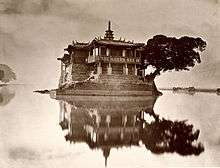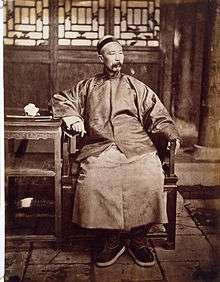Photography in China
Photography in China dates back to the early 19th century with the arrival of European photographers in Macao. In the 1850s, western photographers set up studios in the coastal port cities, but soon their Chinese assistants and local competition spread to all regions.
By the end of the nineteenth century, all major cities had photographic studios where middle-class Chinese could have portraits taken for family occasions. Western and Chinese photographers documented ordinary street life, major wars, and prominent figures. Affluent Chinese adopted photography as a hobby. Empress Dowager Cixi had her portrait taken repeatedly. In the twentieth century, photography in China—as in other countries around the world—was used for recreation, record keeping, newspaper and magazine journalism, political propaganda, and fine-art photography.
According to the scholar Meccarelli, Chinese photography is the result of several factors:
- the study of optics (invention of camera obscura)
- the development of modern chemistry (photosensitive substances)
- the diffusion and settlement of Western medicine (especially anatomy)
- the presence of Westerners and missionaries (know-how and use of the photographic tool)
1842–1890, early history



.jpg)
Early images
- Dr Richard Woosnam
- Major George Malcoln
- Henry Collen
- Jules Itier
- Zou Boqi
Early studios
In the second half of the 19th century, some Chinese photo studios were establied, such as Kung Tai (公泰照相樓)[1] and Sze Yuen Ming (上洋耀華照相) in Shanghai, and Pun Lun (繽綸) and Lai Afong (赖阿芳) in Hong Kong.
- George R. West
- Hugh Mackay
Pioneers of photography in China
- Felice Beato (British, 1832–1909)
- John Thomson (British, 1837–1921)
- Afong Lai (Chinese, 1839–1900)
The first half of the 20th century
- Gao Fan (1922–2004) wartime and post-1949 photographer .[2]
- Ho Fan (1937-, 何藩) photographer and filmmaker
- Liu Bannong (1891–1934, 劉半農) documentary
- Lang Jingshan (Long Chin-san; 1892–1995). Considered China's first photojournalist.
- Niu Weiyu photographer of Chinese Communist Party leaders and wartimes activities.
- Gao Fan (1922–2004) wartime and post-1949 photographer.[2]
- Sha Fei (1912–1948)
- Zhang Yin Quan (1900–1971, 張印泉) documentary
Cultural Revolution (1966–1976)
Photography in China was seen as a Socialist Realist propagandist tool. Li Zhensheng was one of the few photographers who managed to take pictures in an honest way during the Cultural Revolution. Subjects of his Cultural Revolution photographs included "negative" scenes such public humiliation, street violence, executions, etc., as well as "positive" moments, like people studying Mao's works, singing revolutionary slogans, performing loyalty dance, and participating in farm work, etc. Li's photographs of the Cultural Revolution are published in a book titled "Red-Color News Soldier" by Phaidon.
1976–1993
The April Fifth Movement in 1976 marked the start of a new photographic vision in China. During the movement, ordinary citizens (amateur photographers) picked up the cameras and documented people's public mourning for Chinese Premier Zhou Enlai in Tiananmen Square in Beijing. A couple of years later, some of these photographs were published in a book called "People's Mourning". Many of these amateur photographers became professional ones and joined the official press. They also found an unofficial photo club called "April Photo Society."
The aftermath of the Cultural Revolution led to a documentary photography movement that rapidly grew in strength. Many photojournalists worked for the state, and therefore they do not own their copyright in their work.
1993–present
The establishment in 1993 of the East Village area of the capital Beijing, established an artistic coterie that used photography as an adjunct to experimental performance art and conceptual art. In 1994, Rong Rong co-founded the first Chinese conceptual art photography magazine, New Photo.
Many artist-photographers have had success, especially in the west. Although their work has not been as explicitly political as that by very similar conceptual artists in the west, it has used the same repertoire of 'shock'; nakedness, swear words, dead babies and elephant dung, among other items that have now become tired clichés. Some photographers also work in 'Chinese kitsch' – sometimes called "Mao goes Pop" – a collage style very similar to western pop art of the 1960s. Presently, we are reminded of the discursive autonomy contemporary Chinese art is increasingly afforded, seen in works by artists such as Xu Zhen, Xing Danwen, and Zhang Yue – artists who can not be easily summarized under the umbrella of a single artistic praxis such as "kitsch" or "pop" or "shock."
Chinese magazines for photography
- Chinese Photography (中國攝影, Peking) publishing as of 1957
- Popular Photography (大众攝影 (大衆攝影), Peking) publishing as of 1958
See also
- Felice Beato
- Henri Cartier-Bresson
- Robert Capa
- China Lucky Film
- Auguste François
- Hakuyō Fuchikami
- Greg Girard
- Tadahiko Hayashi
- Joris Ivens
- Hou Bo
- Li Zhensheng
- Liu Xucang
- Lu Guang
- Ma Liuming
- Hedda Morrison
- Mu Qing
- Ou Ning
- Qiu Zhijie
- Eva Sandberg
- Marc Riboud
- Pierre Rossier
- William Saunders (photographer)
- John Thomson (photographer)
- Xia Xiao Wan
- Xu Xiaobing
- Yip Cheong Fun
- Zheng Guogu
- Zhang Ou
Further reading
- Naomi Rosenblum, A World History of Photography
- Brush & Shutter: Early Photography in China, 2011, Getty Publications/Hong Kong University Press, ISBN 978-1606060544
- Bennett, Terry (2009). History of Photography in China 1842–1860. Bernard Quaritch. ISBN 978-0956301208.
- Bennett, Terry (2013). History of photography in China : Chinese photographers, 1844–1879. London: Quaritch. ISBN 978-0956301246.
- Chen, Shi (2009). Early Chinese Photographers from 1840 to 1870: Innovation and Adaptation in the Development of Chinese Photography (PDF) (Master of Arts thesis). University of Florida. Retrieved 26 February 2015.
- Roberts, Claire (2012). Photography and China (Exposures). Durrington, UK: Reaktion Books. ISBN 978-1861899118.CS1 maint: ref=harv (link)
- Meccarelli M., Foo Y., Flamminii A. "China and the West in the Art of the Nineteenth Century: A Cultural and Historical Review of the Relations between Painting and Photography" Ming Qing Studies 2013, pp. 117–160
- Meccarelli M. "New Perspectives about the Origins of Chinese Photography and Western Research in China" in ARTE DAL MEDITERRANEO AL MAR DELLA CINA Genesi ed incontri di scuole e stili. Scritti in onore di Paola Mortari Vergara Caffarelli eds. P. Fedi-M. Paolillo, Officina di Studi Medievali, Palermo, 2015, pp. 587–598
- Kent, Richard K. (2013). "Early Twentieth-Century Art Photography in China: Adopting, Domesticating, and Embracing the Foreign". Local Culture/Global Photography. 3 (2). hdl:2027/spo.7977573.0003.204.
References
- http://cs.nga.gov.au/Detail.cfm?IRN=177120
- Lin Qi "A life in pictures," China Daily (June 13, 2017)
External links
- chinese-photography.net : a virtual exhibition of a private collection of Chinese contemporary photographs
- Bibliography of Materials related to Photography in China before 1949
- Shadows of the East, on the "Humanism in China" exhibition on Chinese Photography
- "Between Past and Future, new photography and video from China exhibition". Victoria and Albert Museum. Retrieved 2007-06-16.
- "Body Language: Contemporary Chinese Photography exhibition". National Gallery of Victoria. Archived from the original on 2008-03-15. Retrieved 2008-04-21.
- "Action - Camera: Beijing Performance Photography". Morris and Helen Belkin Art Gallery
- Bibliography of Photo-albums and Materials related to Photography in China and Tibet before 1949
- 中國摄影博物馆・中国最早的老照相馆考证及名录